In September 2013, Laterite presented new work on Rwanda’s manufacturing, agribusiness and exports sectors at an International Growth Centre (IGC) conference.
Laterite prepared this work for the Learning-to-Compete program, a collaborative effort of the Africa Growth Initiative at the Brookings Institute. The IGC coordinates the program in Rwanda.
Book: Understanding Rwanda’s agribusiness and manufacturing sectors
This book follows the 50th anniversary of Rwanda’s Independence, providing the first ever comprehensive overview of firms in the country’s agribusiness and manufacturing sectors.
The book puts these sectors into context historically, explaining how decisions and initiatives going back to the 1930s have determined the shape and composition of agribusiness and manufacturing in Rwanda today.
Further, the book provides an in-depth analysis of agribusiness and manufacturing in Rwanda today. It focuses on understanding the origins, evolution and capabilities of firms, and how these capabilities came to be.
It does this by mapping existing firms along five dimensions: ownership structures, products, systems, resources and exports. Finally, the book individually profiles 43 of Rwanda’s largest manufacturing and agribusiness firms.
This book is targeted at policymakers, academics, business people, and prospective investors interested in gaining a better understanding of Rwanda’s industrial sector.
Some generous words by Richard Newfarmer, the IGC Country Director for Rwanda, South Sudan & Uganda:
“In one of the first assessments of post-genocide Rwanda’s industry, economists Gathani and Stoelinga provide an insightful and comprehensive analysis of the sector’s growth and its considerable potential. Well written and accessible, their trenchant insights into recent economic performance provide required reading for prospective investors and those charting the rapid development of Rwanda.”
Paper: Understanding Rwanda’s exports sector
This paper focuses on the dynamics of firms, products and destinations, particularly in the non-commodity exports sector. Our brief summarizes the findings.
